Factors Influencing the Spatiotemporal Changes of Permafrost in Northeast China from 1982 to 2020
Abstract
1. Introduction
2. Materials and Methods
2.1. Study Area
2.2. Data
2.3. Methods
2.3.1. Surface Frost Number Model
2.3.2. Ordinary Kriging Interpolation Method
2.3.3. Permafrost Change Rate
2.3.4. Slope Trend Analysis Method
2.3.5. Kappa Coefficient
3. Results
3.1. Permafrost Distribution Estimation and Accuracy Verification
3.2. Spatiotemporal Variations of Permafrost
3.2.1. Temporal Variation Characteristics of Permafrost
3.2.2. Spatial Variation Characteristics of Permafrost
3.3. Analysis of the Influencing Factors of Permafrost Change
3.3.1. Variation Characteristics of the Influencing Factors
3.3.2. Spatiotemporal Correlation Analysis of Permafrost and its Influencing Factors
4. Discussion
4.1. The Surface Frost Number Model and Permafrost
4.2. Influencing Factors
4.3. Limitations and Prospects
5. Conclusions
Author Contributions
Funding
Data Availability Statement
Acknowledgments
Conflicts of Interest
References
- Dobinski, W. Permafrost. Earth-Sci. Rev. 2011, 108, 158–169. [Google Scholar] [CrossRef]
- Cui, Y.; Sheng, Y.; Zhang, Z. Influence of Environmental Factors on Distribution and Development of Xing’an-Baikal Permafrost. J. Jilin Univ. (Earth Sci. Ed.) 2021, 51, 1427–1440. [Google Scholar] [CrossRef]
- Streletskiy, D.; Anisimov, O.; Vasiliev, A. Permafrost Degradation//Snow and Ice-Related Hazards, Risks, and Disasters; Haeberli, W., Whiteman, C., Eds.; Elsevier: Amsterdam, The Netherlands, 2014; pp. 303–344. [Google Scholar] [CrossRef]
- Qin, Y.; Lei, H.; Yang, D.; Gao, B.; Wang, Y.; Cong, Z.; Fan, W. Long-term change in the depth of seasonally frozen ground and its ecohydrological impacts in the Qilian Mountains, northeastern Tibetan Plateau. J. Hydrol. 2016, 542, 204–221. [Google Scholar] [CrossRef]
- Che, L.; Cheng, M.; Xing, L.; Cui, Y.; Wan, L. Effects of permafrost degradation on soil organic matter turnover and plant growth. Catena 2022, 208, 105721. [Google Scholar] [CrossRef]
- Guo, J.; Han, F.; Hu, Y. Ecological characteristics of vegetation and their responses to permafrost degradation in the north slope of Great Khingan Mountain valley of northeast China. Acta Ecol. Sin. 2017, 37, 6552–6561. [Google Scholar] [CrossRef]
- Camill, P.; Clark, J.S. Long-term perspectives on lagged ecosystem responses to climate change: Permafrost in boreal peatlands and the grassland/woodland boundary. Ecosystems 2000, 3, 534–544. [Google Scholar] [CrossRef]
- AminiTabrizi, R.; Wilson, R.M.; Fudyma, J.D.; Hodgkins, S.B.; Heyman, H.M.; Rich, V.I.; Saleska, S.R.; Chanton, J.P.; Tfaily, M.M. Controls on soil organic matter degradation and subsequent greenhouse gas emissions across a permafrost thaw gradient in Northern Sweden. Front. Earth Sci. 2020, 8, 557961. [Google Scholar] [CrossRef]
- Hjort, J.; Streletskiy, D.; Doré, G.; Wu, Q.; Bjella, K.; Luoto, M. Impacts of permafrost degradation on infrastructure. Nat. Rev. Earth Environ. 2022, 3, 24–38. [Google Scholar] [CrossRef]
- Lu, G.; Weng, B.; Guo, D. Geographical southern limit of permafrost in Northeastern China. J. Glaciol. Geocryol. 1993, 15, 214–218. [Google Scholar]
- Xin, K.; Ren, Q. Distribution of permafrost in Northeast China. Geol. Knowl. 1956, 10, 15–18. [Google Scholar]
- Heginbottom, J.A. Permafrost mapping: A review. Prog. Phys. Geogr. 2002, 26, 623–642. [Google Scholar] [CrossRef]
- Zhang, X.; Nan, Z.; Wu, J.; Du, E.; Wang, T.; You, Y. Mountain permafrost distribution modeling using Multivariate Adaptive Regression Spline (MARS) in the Wenquan area over the Qinghai-Tibet Plateau. Sci. Cold Arid. Reg. 2012, 4, 361–370. [Google Scholar] [CrossRef]
- Nelson, F.E. Permafrost distribution in central Canada: Applications of a climate-based predictive model. Ann. Assoc. Am. Geogr. 1986, 76, 550–569. [Google Scholar] [CrossRef]
- Lü, J.; Li, X.; Hu, Y.; Wang, X.; Sun, J. Application of frost number model in Northeast China pepmafrost regionalization. Yingyong Shengtai Xuebao 2008, 19, 2271–2276. [Google Scholar]
- Nan, Z.; Li, S.; Cheng, G.; Huang, P. Surface frost number model and its application to the Tibetan plateau. J. Glaciol. Geocryol. 2012, 34, 89–95. [Google Scholar]
- Ran, Y.; Li, X.; Jin, R.; Guo, J. Remote sensing of the mean annual surface temperature and surface frost number for mapping permafrost in China. Arct. Antarct. Alp. Res. 2015, 47, 255–265. [Google Scholar] [CrossRef]
- Wei, Z.; Jin, H.; Zhang, J.; Yu, S.; Han, X.; Ji, Y.; He, R.; Chang, X. Prediction of permafrost changes in Northeastern China under a changing climate. Sci. China Earth Sci. 2011, 54, 924–935. [Google Scholar] [CrossRef]
- Chen, S.; Zang, S.; Sun, L. Permafrost degradation in Northeast China and its environmental effects: Present situation and prospect. J. Glaciol. Geocryol. 2018, 40, 298–306. [Google Scholar] [CrossRef]
- Guo, D.; Wang, S.; Lu, G.; Dan, J. Division of Permafrost Regions in Daxiao Hinggan Ling Northeast China. J. Glaciol. Geocryol. 1981, 3, 1–9. [Google Scholar]
- Xie, Y. Climatic Condition in the Formation and Evolution of Permafrost in Northeast China. J. Glaciol. Geocryol. 1985, 7, 323–330. [Google Scholar]
- Zhou, Y.; Wang, Y.; Gao, X.; Yue, H. Ground Temperature, Permafrost Distribution and Climate Warming in Northeastern China. J. Glaciol. Geocryol. 1996, S1, 9. [Google Scholar]
- He, R.; Jin, H.; Chang, X.; Lv, L.; Yu, S.; Yang, S.; Wang, S.; Sun, G. Degradation of permafrost in the northern part of northeastern China: Present state and causal analysis. J. Glaciol. Geocryol. 2009, 31, 829–834. [Google Scholar] [CrossRef]
- Wang, F.; Li, G.; Ma, W.; Wu, Q.; Serban, M.; Vera, S.; Alexandr, F.; Jiang, N.; Wang, B. Pipeline–permafrost interaction monitoring system along the China–Russia crude oil pipeline. Eng. Geol. 2019, 254, 113–125. [Google Scholar] [CrossRef]
- Zhang, Z.; Wu, Q.; Hou, M.; Tai, B.; An, Y. Permafrost change in Northeast China in the 1950s–2010s. Adv. Clim. Chang. Res. 2021, 12, 18–28. [Google Scholar] [CrossRef]
- Zhan, D.; Man, H.; Zang, S.; Li, M. Simulation of frozen ground distribution in northeast China based on a surface frost number model. J. Geogr. Sci. 2022, 32, 1581–1600. [Google Scholar] [CrossRef]
- Zhou, M.; Yu, X.; Feng, L. Analysis on the driving force of the permafrost degeneration in Daxinganling. J. Arid Land Resour. Environ. 2002, 4, 44–47. [Google Scholar] [CrossRef]
- Zhou, X.; Zhao, C.; Li, N.; Liu, M.; Cui, Y.; Ao, X. Influence of snow and temperature on the depth of frozen soil in winter half year in Northeast China. J. Glaciol. Geocryol. 2021, 43, 1027–1039. [Google Scholar] [CrossRef]
- Chang, X.; Jin, H.; Wang, Y.; Zhang, Y.; Zhou, G.; Che, F.; Zhao, Y. Influences of vegetation on permafrost: A review. Acta Ecol. Sin. 2012, 32, 7981–7990. [Google Scholar] [CrossRef]
- Zhu, X.; Wu, T.; Zhao, L.; Yang, C.; Zhang, H.; Xie, C.; Li, R.; Wang, W.; Hu, G.; Ni, J. Exploring the contribution of precipitation to water within the active layer during the thawing period in the permafrost regions of central Qinghai-Tibet Plateau by stable isotopic tracing. Sci. Total Environ. 2019, 661, 630–644. [Google Scholar] [CrossRef]
- Gao, H.; Sa, C.; Meng, F.; Luo, M.; Wang, M.; Zhang, H. Temporal and spatial characteristics of permafrost on Mongolian Plateau from 2003 to 2019. J. Arid Land Resour. Environ. 2022, 36, 99–106. [Google Scholar] [CrossRef]
- Chen, S.; Zang, S.; Sun, L. Dynamic Variation of Soil Moisture and Impact in Permafrost Regions in Northeast China. Res. Soil Water Conserv. 2020, 27, 113–118. [Google Scholar] [CrossRef]
- Li, X.; Cheng, G.; Jin, H.; Kang, E.; Che, T.; Jin, R.; Wu, L.; Nan, Z.; Wang, J.; Shen, Y. Cryospheric change in China. Glob. Planet. Chang. 2008, 62, 210–218. [Google Scholar] [CrossRef]
- Liu, J.; Hayakawa, N.; Lu, M.; Dong, S.; Yuan, J. Winter streamflow, ground temperature and active-layer thickness in northeast China. Permafr. Periglac. Process. 2003, 14, 11–18. [Google Scholar] [CrossRef]
- Shi, Y.; Mi, D. Distribution map of frozen ground in China based on Map of Snow, Ice and Frozen Ground in China. Natl. Tibet. Plateau Data Cent. 2013. [Google Scholar] [CrossRef]
- Ran, Y.; Li, X.; Cheng, G.; Zhang, T.; Wu, Q.; Jin, H.; Jin, R. Distribution of permafrost in China: An overview of existing permafrost maps. Permafr. Periglac. Process. 2012, 23, 322–333. [Google Scholar] [CrossRef]
- Nelson, F.E.; Outcalt, S.I. A computational method for prediction and regionalization of permafrost. Arct. Antarct. Alp. Res. 1987, 19, 279–288. [Google Scholar] [CrossRef]
- Hu, J.; Zhao, S.; Nan, Z.; Wu, X.; Sun, X.; Cheng, G. An effective approach for mapping permafrost in a large area using subregion maps and satellite data. Permafr. Periglac. Process. 2020, 31, 548–560. [Google Scholar] [CrossRef]
- Luo, D.; Jin, H.; Marchenko, S.S.; Romanovsky, V.E. Difference between near-surface air, land surface and ground surface temperatures and their influences on the frozen ground on the Qinghai-Tibet Plateau. Geoderma 2018, 312, 74–85. [Google Scholar] [CrossRef]
- Le, N.D.; Zidek, J.V. Statistical Analysis of Environmental Space-Time Processes; Springer: Berlin/Heidelberg, Germany, 2006. [Google Scholar]
- Zhang, X.; Zang, S.; Sun, L. Spatial-temporal variation characteristics of snow cover days in Northeast China in the past 40 years and their relationship with climatic factors. Adv. Earth Sci. 2018, 33, 958–968. [Google Scholar] [CrossRef]
- Cohen, J. A coefficient of agreement for nominal scales. Educ. Psychol. Meas. 1960, 20, 37–46. [Google Scholar] [CrossRef]
- Shi, Y.; Niu, F.; Yang, C.; Che, T.; Lin, Z.; Luo, J. Permafrost presence/absence mapping of the Qinghai-Tibet Plateau based on multi-source remote sensing data. Remote Sens. 2018, 10, 309. [Google Scholar] [CrossRef]
- Landis, J.R.; Koch, G.G. The measurement of observer agreement for categorical data. Biometrics 1977, 33, 159–174. [Google Scholar] [CrossRef] [PubMed]
- Chang, X.; Jin, H.; Yu, S.; Sun, H.; He, R.; Luo, D.; Sun, G.; Lu, L. Influence of vegetation on frozen ground temperatures the forested area in the Da Xing’anling Mountains, Northeastern China. Shengtai Xuebao/Acta Ecol. Sin. 2011, 31, 5138–5147. [Google Scholar]
- Zan, G.; Sun, T. Vegetation cover change on Hulun Buir grassland. For. Resour. Wanagement 2011, 1, 44–48. [Google Scholar] [CrossRef]
- Le Roy Ladurie, E. Climate and Its History. Rev. BNF 2010, 36, 5–11. [Google Scholar] [CrossRef]
- Walther, G.; Post, E.; Convey, P.; Menzel, A.; Parmesan, C.; Beebee, T.J.; Fromentin, J.; HoeghGuldberg, O.; Bairlein, F. Ecological responses to recent climate change. Nature 2002, 416, 389–395. [Google Scholar] [CrossRef] [PubMed]
- Han, L.; Tsunekawa, A.; Tsubo, M.; He, C.; Shen, M. Spatial variations in snow cover and seasonally frozen ground over northern China and Mongolia, 1988–2010. Glob. Planet. Chang. 2014, 116, 139–148. [Google Scholar] [CrossRef]
- Ling, F.; Zhang, T. Impact of the timing and duration of seasonal snow cover on the active layer and permafrost in the Alaskan Arctic. Permafr. Periglac. Process. 2003, 14, 141–150. [Google Scholar] [CrossRef]
- Guo, J.; Hu, Y.; Xiong, Z.; Yan, X.; Li, C.; Bu, R. Variations in growing-season NDVI and its response to permafrost degradation in Northeast China. Sustainability 2017, 9, 551. [Google Scholar] [CrossRef]
- Daut, I.; Yusoff, M.I.; Ibrahim, S.; Irwanto, M.; Nsurface, G. Relationship between the solar radiation and surface temperature in Perlis. Adv. Mater. Res. 2012, 512–515, 143–147. [Google Scholar] [CrossRef]
- Alexander, L.V.; Zhang, X.; Peterson, T.C.; Caesar, J.; Gleason, B.; Klein Tank, A.; Haylock, M.; Collins, D.; Trewin, B.; Rahimzadeh, F. Global observed changes in daily climate extremes of temperature and precipitation. J. Geophys. Res. Atmos. 2006, 111, 1042–1063. [Google Scholar] [CrossRef]
- Slater, A.G.; Lawrence, D.M. Diagnosing present and future permafrost from climate models. J. Clim. 2013, 26, 5608–5623. [Google Scholar] [CrossRef]
- Benesty, J.; Chen, J.; Huang, Y.; Cohen, I. Pearson correlation coefficient. In Noise Reduction in Speech Processing; Springer: Berlin/Heidelberg, Germany, 2009; pp. 1–4. [Google Scholar]
- Ma, J.; Tian, F.; Chen, L. Relative importance analysis of debris flow factors based on dominance analysis: A case study of the Bailongjiang Basin in China. J. Lanzhou Univ. (Nat. Sci.) 2014, 50, 722–727. [Google Scholar] [CrossRef]
- Li, X.; Jin, H.; Sun, L.; Wang, H.; Huang, Y.; He, R.; Chang, X.; Yu, S.; Zang, S. TTOP-model-based maps of permafrost distribution in Northeast China for 1961–2020. Permafr. Periglac. Process. 2022, 33, 425–435. [Google Scholar] [CrossRef]
- Zhang, Y.; Zang, S.; Li, M.; Shen, X.; Lin, Y. Spatial Distribution of Permafrost in the Xing’an Mountains of Northeast China from 2001 to 2018. Land 2021, 10, 1127. [Google Scholar] [CrossRef]
- Wang, H.; Liu, B. Change Characteristics of Surface Temperature in Growing Season in Hei long jiang Province in Recent 47 Years. Prot. For. Sci. Technol. 2016, 12, 5. [Google Scholar] [CrossRef]
- Li, S.; Wang, P.; Chen, L.; Jiang, L.; Wang, L.; Gong, L. Variation features and prediction of the topsoil (0–20 cm) ground temperature of spring in Heilongjiang Province. J. Glaciol. Geocryol. 2014, 36, 8. [Google Scholar] [CrossRef]
- Ban, J.; Li, Y.; Zhao, J.; Sun, M. Cause Analysis of Temperature Anomaly in Heilongjiang Province in Winter of 2017-2018. Heilongjiang Meteorol. 2019, 36, 14–17. [Google Scholar] [CrossRef]
- Shur, Y.L.; Jorgenson, M.T. Patterns of permafrost formation and degradation in relation to climate and ecosystems. Permafr. Periglac. Process. 2007, 18, 7–19. [Google Scholar] [CrossRef]
- Jin, X.; Jin, H.; Iwahana, G.; Marchenko, S.S.; Luo, D.; Li, X.; Liang, S. Impacts of climate-induced permafrost degradation on vegetation: A review. Adv. Clim. Chang. Res. 2021, 12, 29–47. [Google Scholar] [CrossRef]
- Sun, G.; Yu, S.; Wang, H. Causes, south borderline and subareas of permafrost in Da Hinggan mountains and Xiao Hinggan Mountains. Sci. Geogr. Sin. 2007, 27, 68. [Google Scholar] [CrossRef]
- Kudryavtsev, V.; Garagulya, L.; Melamed, V. Fundamentals of Frost Forecasting in Geological Engineering Investigations (Osnovy Merzlotnogo Prognoza pri Inzhenerno-Geologicheskikh Issledovaniyakh); Cold Regions Research and Engineering Lab Hanover NH: Hanover, Germany, 1977. [Google Scholar]
- Chen, Y.; Yin, Y. Impacts of forest industry development in the Da Xing’anling Mountains on the seasonally thawed layer overlying permafrost. In Proceedings of the 5th Chinese Conference on Glaciology and Geocryology, Gansu Culture Press, Lanzhou, China, 18 August 1996. [Google Scholar]
- Luthin, J.; Guymon, G. Soil moisture-vegetation-temperature relationships in central Alaska. J. Hydrol. 1974, 23, 233–246. [Google Scholar] [CrossRef]
- Goodrich, L. Some results of a numerical study of ground thermal regimes. In Proceedings of the 3rd International Conference on Permafrost, Edmonton, AB, Canada, 10 July 1978. [Google Scholar]
- Zhang, H.; Fan, J.; Gao, D.; Liu, Y.; Du, H. Effect of Decreasing the Interception of Solar Illuminance by Vegetation on Ground Temperature in Degraded Grasslands. Sustainability 2022, 14, 4488. [Google Scholar] [CrossRef]
- Boike, J.; Roth, K.; Overduin, P.P. Thermal and hydrologic dynamics of the active layer at a continuous permafrost site (Taymyr Peninsula, Siberia). Water Resour. Res. 1998, 34, 355–363. [Google Scholar] [CrossRef]
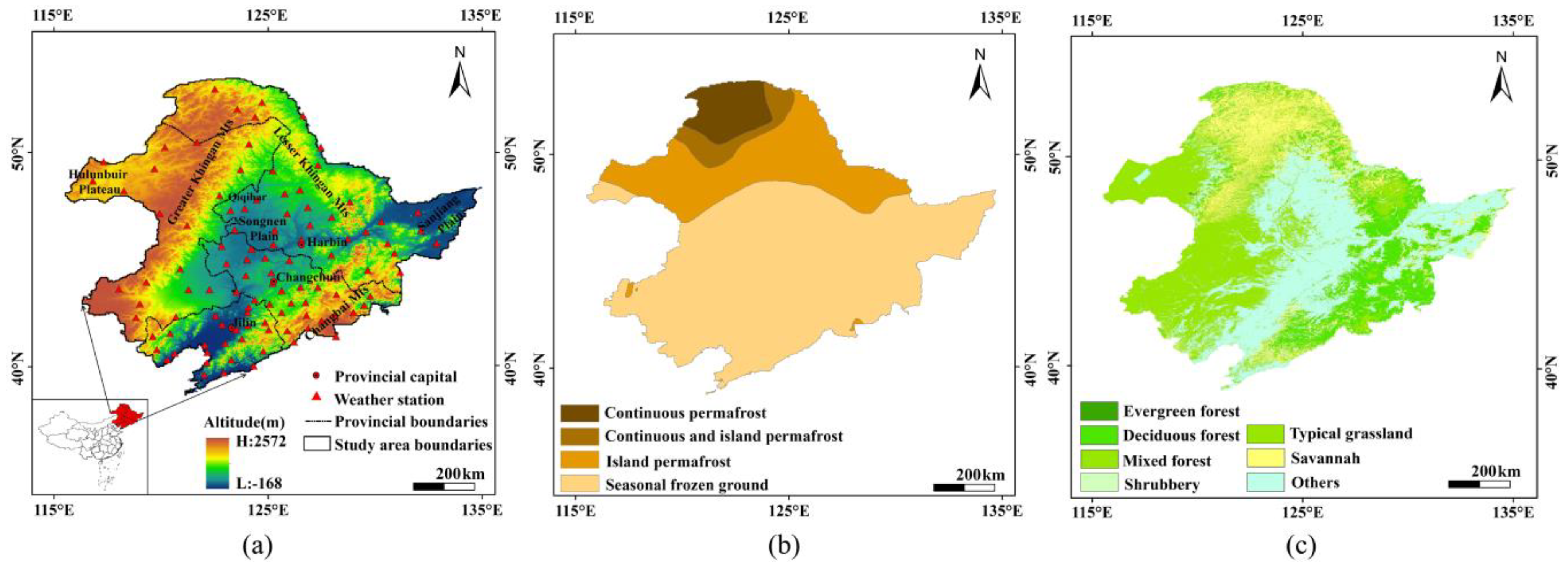

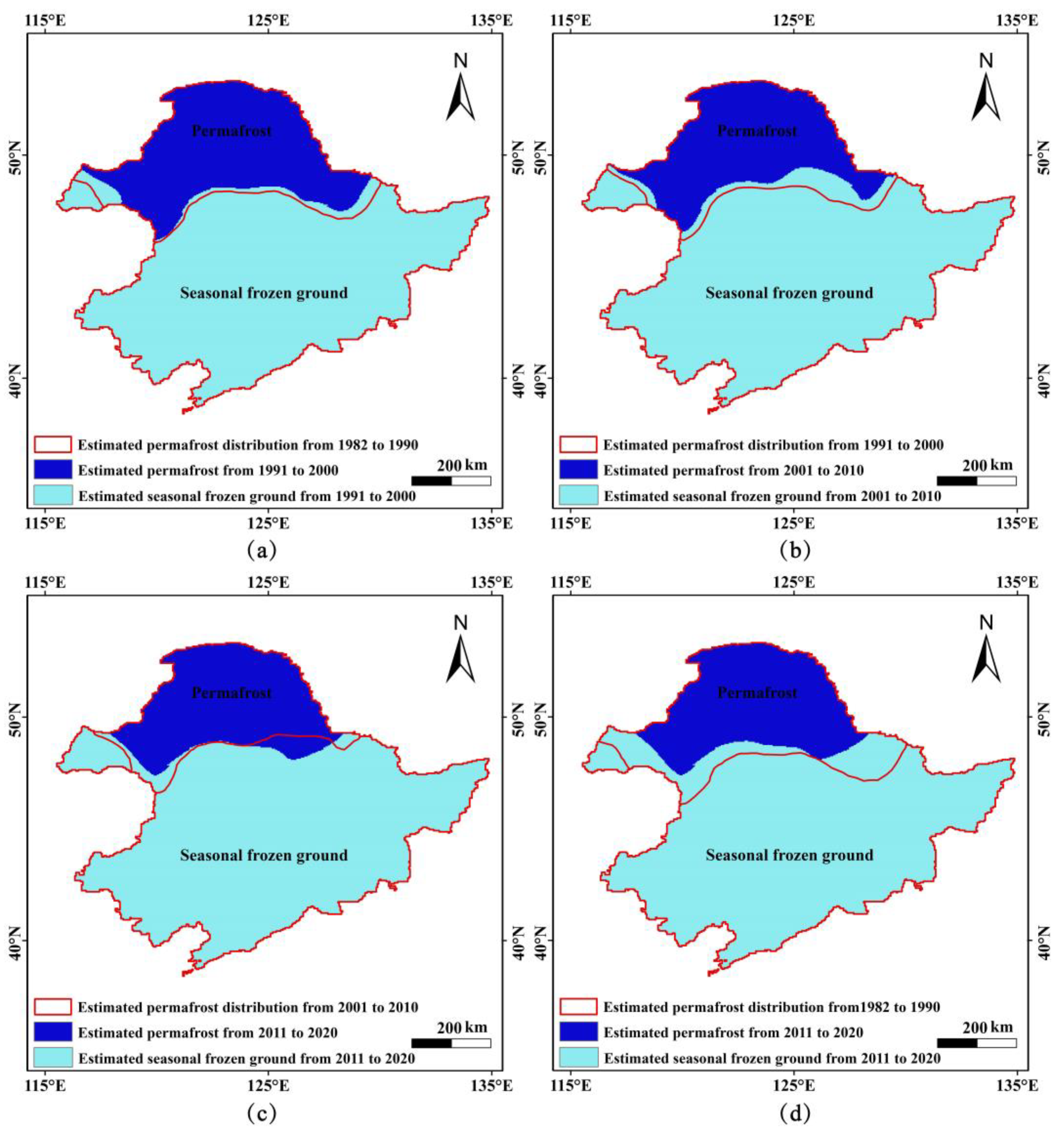
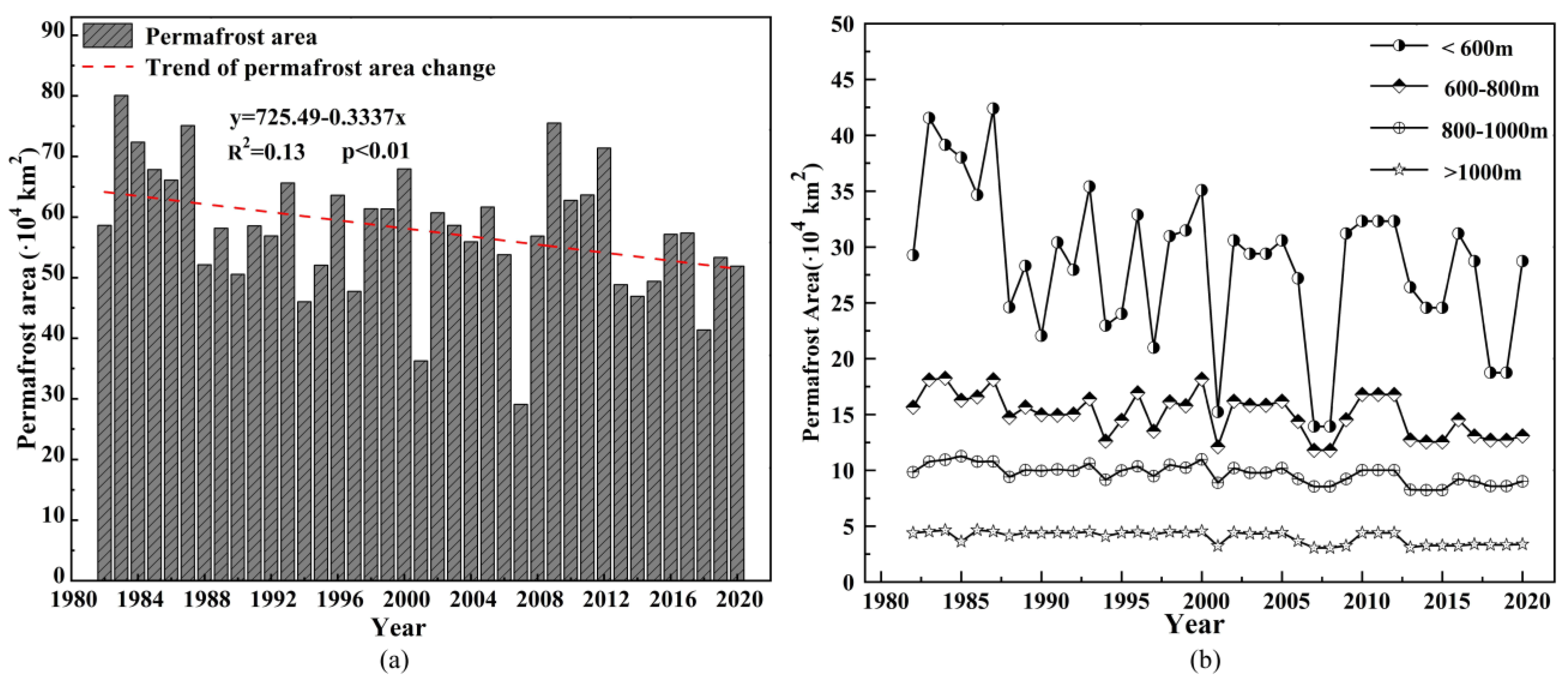
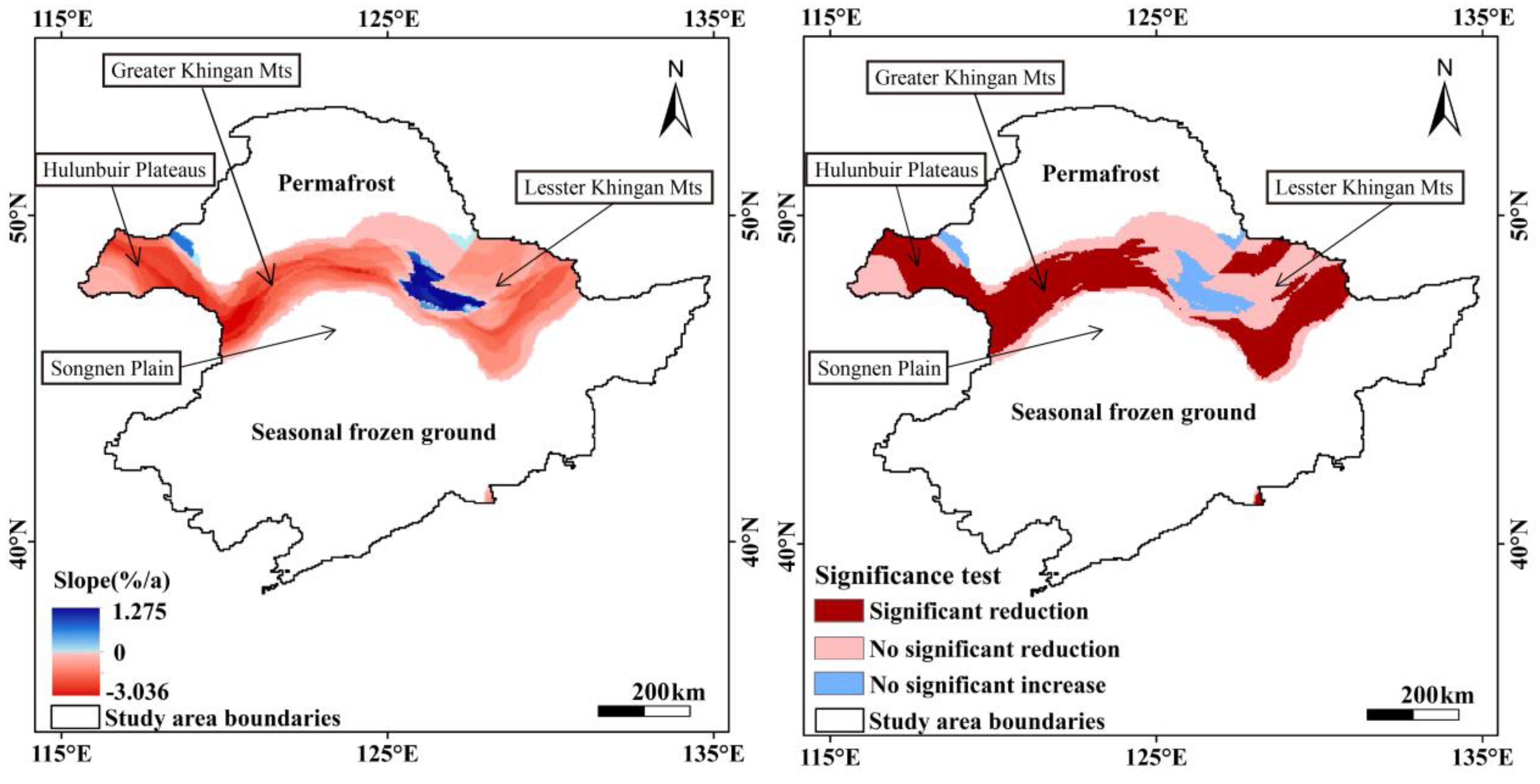
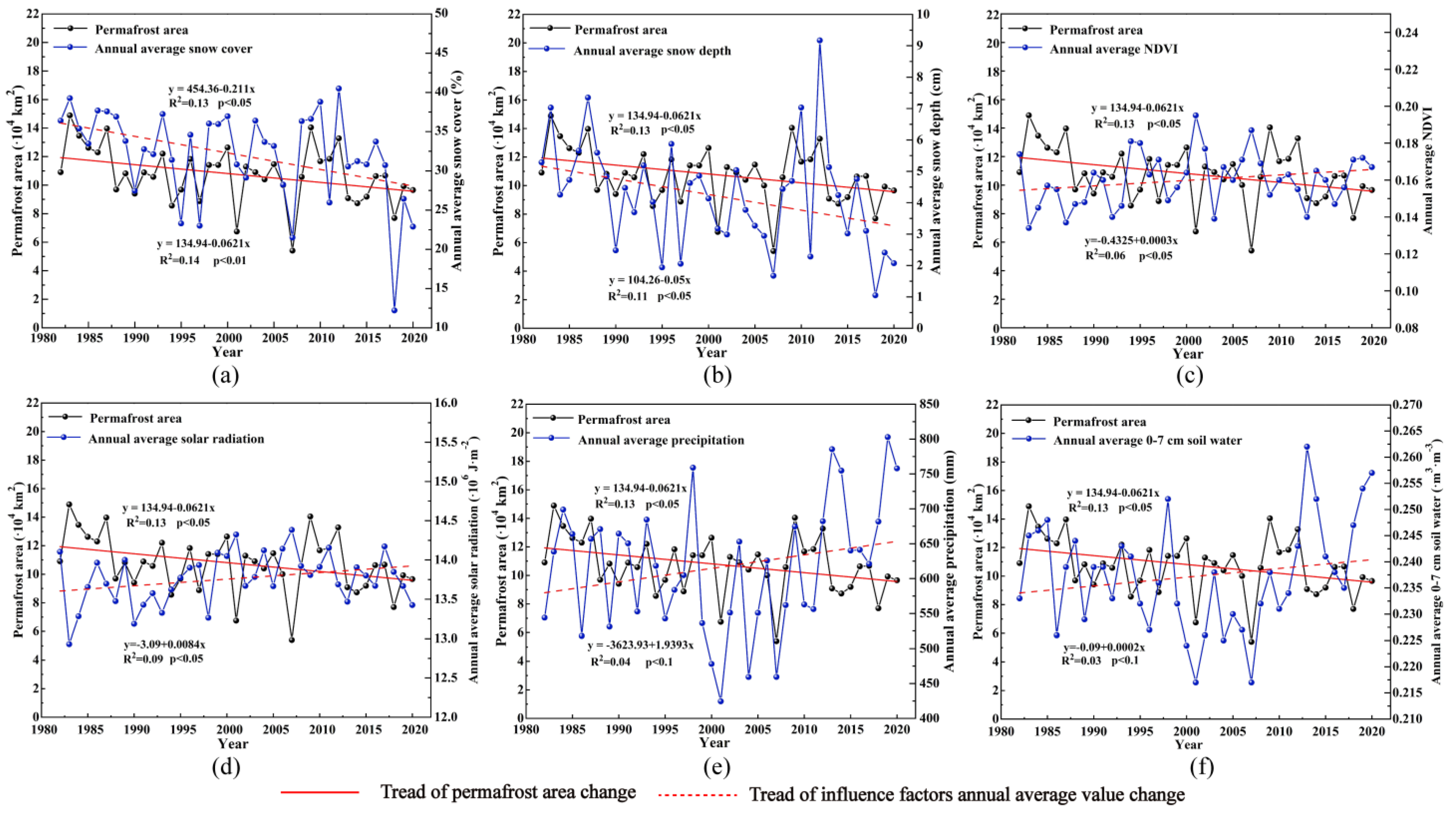
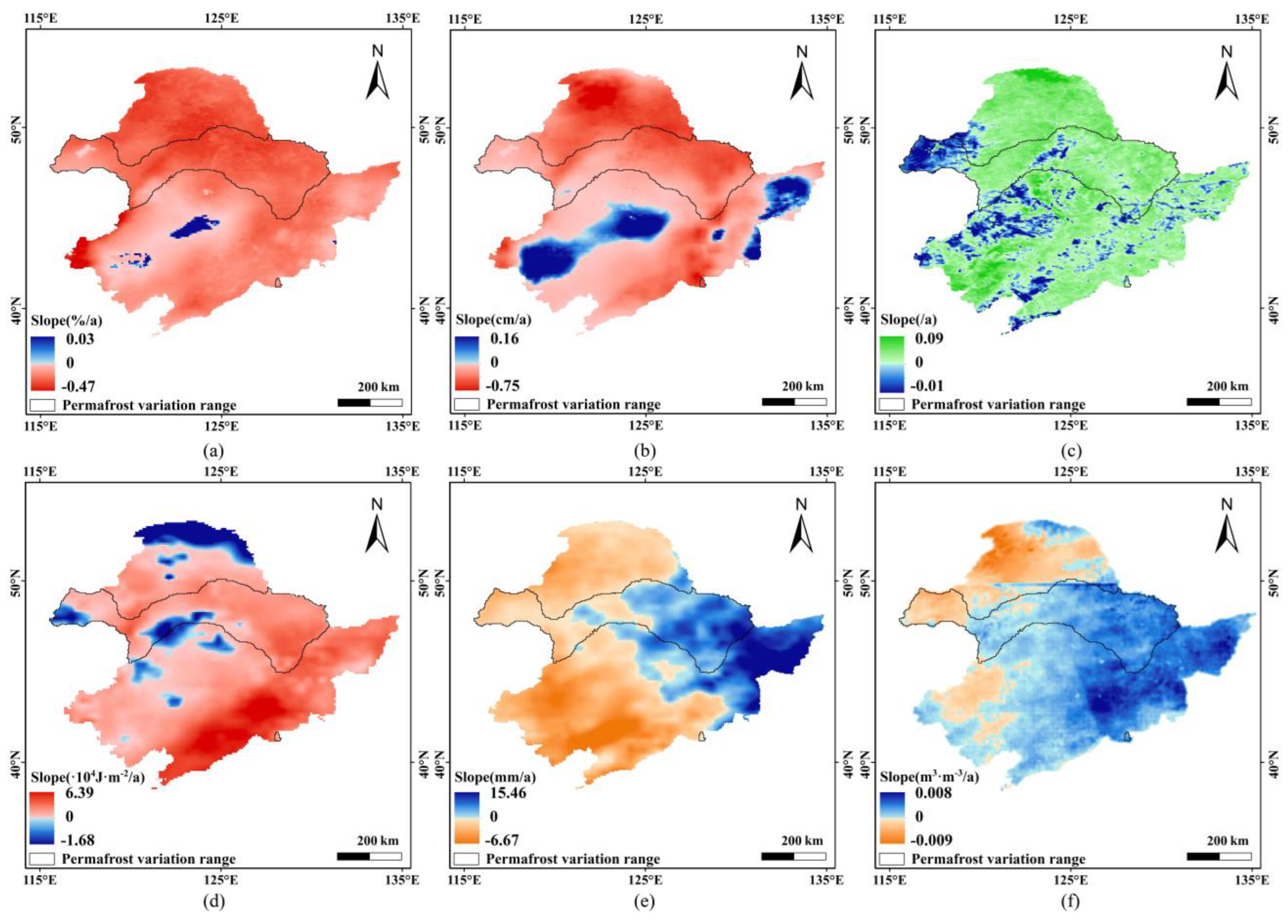
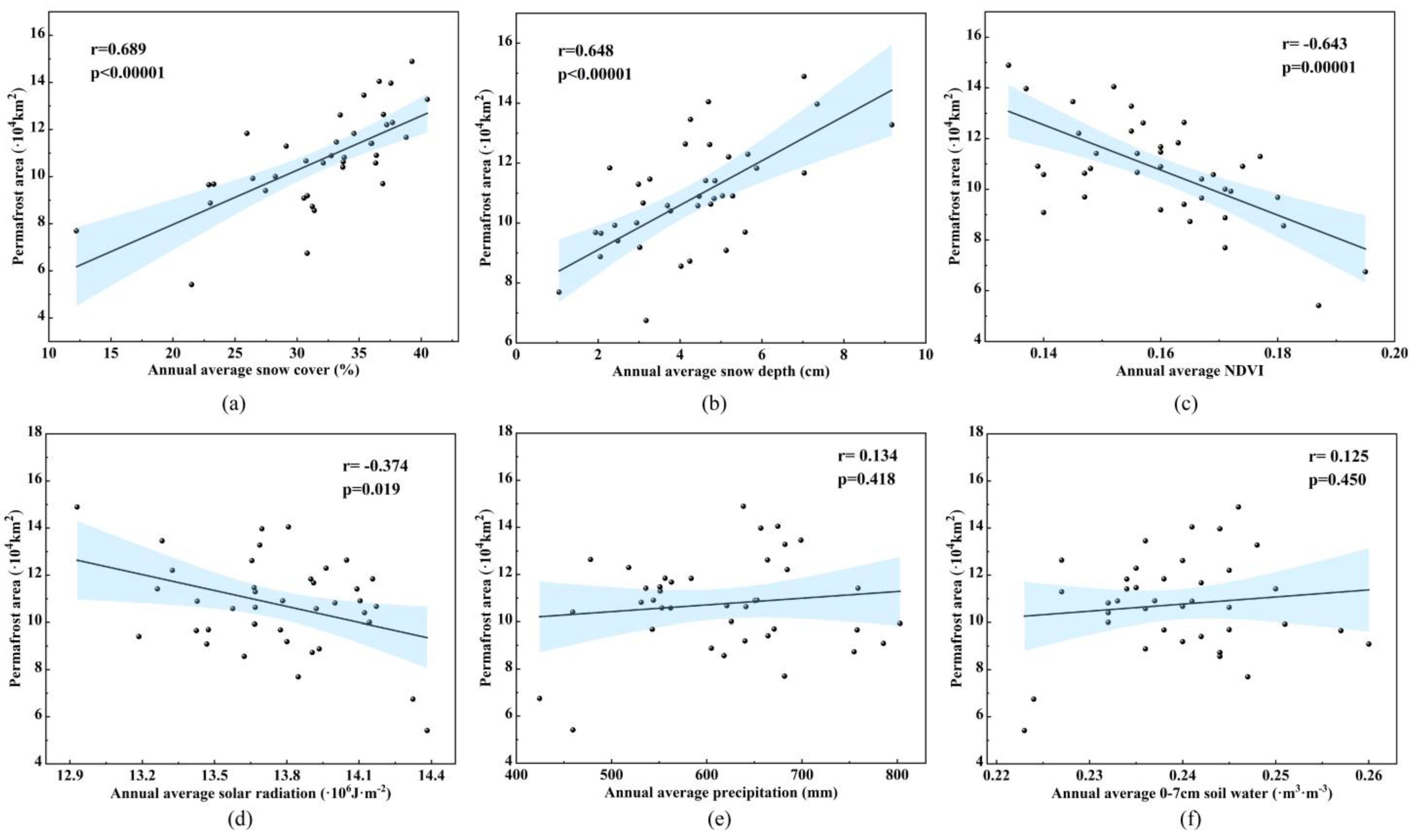
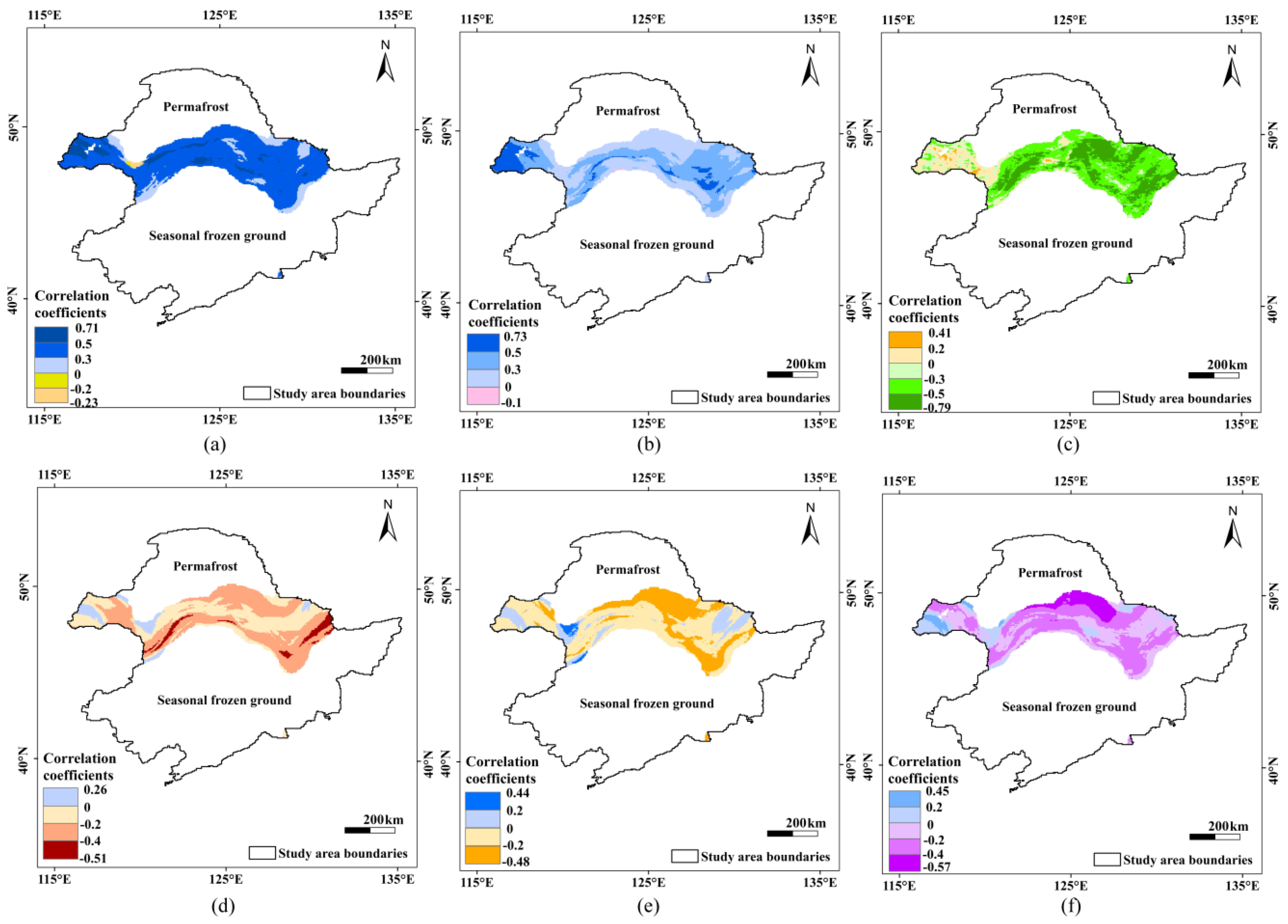
| Data Source | Vegetation Types | Area of Significant Decrease in Permafrost (×104 km2) | Percentage of Total Area Decrease (%) | Area of Insignificant Decrease in Permafrost (×104 km2) | Percentage of Total Area Decrease (%) | Area of Insignificant Increase in Permafrost (×104 km2) | Percentage of Total Area Increase (%) |
|---|---|---|---|---|---|---|---|
| MCD 12Q1 | Evergreen-forest | 0.009 | 0.02 | 0.022 | 0.05 | 0 | 0 |
| Deciduous-forest | 4.777 | 11.85 | 3.278 | 8.13 | 0.149 | 4.64 | |
| Mixed-forest | 1.428 | 3.54 | 0.982 | 2.44 | 0.003 | 0.09 | |
| Shrubbery | 0 | 0 | 0 | 0 | 0 | 0 | |
| Savannah | 4.61 | 11.44 | 3.343 | 8.29 | 0.254 | 7.94 | |
| Typical-grassland | 6.119 | 15.18 | 3.501 | 8.69 | 0.524 | 16.36 |
| Variable (X) | R2 | Value Added Contribution (ΔR2) | |||||
|---|---|---|---|---|---|---|---|
| X1 | X2 | X3 | X4 | X5 | X6 | ||
| K = 0; Average contribution | 0 | 0.419 | 0.475 | 0.414 | 0.140 | 0.018 | 0.016 |
| X1 | 0.419 | — | 0.067 | 0.108 | 0.049 | 0.004 | 0 |
| X2 | 0.475 | 0.012 | — | 0.102 | 0.059 | 0.03 | 0.021 |
| X3 | 0.414 | 0.114 | 0.163 | — | 0.001 | 0.021 | 0.029 |
| X4 | 0.140 | 0.329 | 0.394 | 0.275 | — | 0.018 | 0.02 |
| X5 | 0.018 | 0.406 | 0.487 | 0.417 | 0.14 | — | 0 |
| X6 | 0.016 | 0.404 | 0.481 | 0.427 | 0.144 | 0.003 | — |
| K = 1; Average contribution | 0.253 | 0.318 | 0.266 | 0.05 | 0.015 | 0.01 | |
| X1X2 | 0.487 | — | — | 0.091 | 0.052 | 0.022 | 0.012 |
| X1X3 | 0.528 | — | 0.05 | — | 0.004 | 0.007 | 0.022 |
| X1X4 | 0.468 | — | 0.071 | 0.063 | — | 0.009 | 0.032 |
| X1X5 | 0.424 | — | 0.085 | 0.111 | 0.054 | — | 0.016 |
| X1X6 | 0.420 | — | 0.079 | 0.13 | 0.081 | 0.021 | — |
| X2X3 | 0.577 | 0.001 | — | — | 0.008 | 0 | 0.001 |
| X2X4 | 0.508 | 0.005 | — | 0.05 | — | 0 | 0 |
| X2X5 | 0.505 | 0.004 | — | 0.072 | 0.029 | — | 0 |
| X2X6 | 0.496 | 0.002 | — | 0.081 | 0.038 | 0.009 | — |
| X3X4 | 0.415 | 0.117 | 0.169 | — | — | 0.036 | 0.047 |
| X3X5 | 0.435 | 0.1 | 0.142 | — | 0.016 | — | 0.008 |
| X3X6 | 0.443 | 0.107 | 0.135 | — | 0.019 | 0 | — |
| X4X5 | 0.158 | 0.32 | 0.376 | 0.293 | — | — | 0.004 |
| X4X6 | 0.160 | 0.341 | 0.374 | 0.302 | — | 0.002 | — |
| X5X6 | 0.018 | 0.422 | 0.487 | 0.425 | 0.143 | — | — |
| K = 2; Average contribution | 0.142 | 0.197 | 0.16 | 0.04 | 0.01 | 0.01 | |
| X1X2X3 | 0.577 | — | — | — | 0.008 | 0 | 0.002 |
| X1X2X4 | 0.539 | — | — | 0.046 | — | 0 | 0.003 |
| X1X2X5 | 0.509 | — | — | 0.069 | 0.031 | — | 0.001 |
| X1X2X6 | 0.499 | — | — | 0.081 | 0.044 | 0.011 | — |
| X2X3X4 | 0.584 | 0.001 | — | — | — | 0.002 | 0.007 |
| X2X3X5 | 0.577 | 0.001 | — | — | 0.01 | — | 0.003 |
| X2X3X6 | 0.578 | 0.002 | — | — | 0.014 | 0.003 | — |
| X3X4X5 | 0.451 | 0.101 | 0.136 | — | — | — | 0.013 |
| X3X4X6 | 0.462 | 0.115 | 0.13 | — | — | 0.001 | — |
| X4X5X6 | 0.162 | 0.344 | 0.375 | 0.302 | — | — | — |
| K = 3; Average contribution | 0.094 | 0.214 | 0.125 | 0.021 | 0.003 | 0.005 | |
| X1X2X3X4 | 0.585 | — | — | — | — | 0.003 | 0.012 |
| X1X2X3X5 | 0.577 | — | — | — | 0.011 | — | 0.005 |
| X1X2X3X6 | 0.579 | — | — | — | 0.017 | 0.004 | — |
| X2X3X4X5 | 0.587 | 0.001 | — | — | — | — | 0.006 |
| X2X3X4X6 | 0.592 | 0.005 | — | — | — | 0.001 | — |
| X3X4X5X6 | 0.464 | 0.115 | 0.129 | — | — | — | — |
| K = 4; Average contribution | 0.04 | 0.129 | 0.015 | 0.003 | 0.008 | ||
| X1X2X3X4X5 | 0.588 | — | — | — | — | — | 0.01 |
| X1X2X3X4X6 | 0.597 | — | — | — | — | 0.01 | — |
| X2X3X4X5X6 | 0.592 | 0.005 | — | — | — | — | — |
| K = 5; Average contribution | 0.005 | 0.01 | 0.01 | ||||
| X1X2X3X4X5X6 | 0.598 | — | — | — | — | — | — |
| Total average contribution | 0.159 | 0.222 | 0.161 | 0.053 | 0.01 | 0.009 | |
| Altitude Range | Soil Type and Percentage of Area (%) | |||||||
|---|---|---|---|---|---|---|---|---|
| SICL | LS | SAC | CL | SIC | SACL | L | SL | |
| <600 m | 7.12 | 14.21 | 0.04 | 12.01 | 9.73 | 0 | 51.27 | 5.62 |
| 600–800 m | 0.82 | 5.17 | 0 | 27.96 | 10.83 | 0 | 47.84 | 7.38 |
| 800–1000 m | 1.17 | 5.34 | 0 | 18.40 | 18.50 | 0 | 52.84 | 3.75 |
| >1000 m | 2.40 | 1.92 | 0 | 36.09 | 10.55 | 0.14 | 46.55 | 2.35 |
Disclaimer/Publisher’s Note: The statements, opinions and data contained in all publications are solely those of the individual author(s) and contributor(s) and not of MDPI and/or the editor(s). MDPI and/or the editor(s) disclaim responsibility for any injury to people or property resulting from any ideas, methods, instructions or products referred to in the content. |
© 2023 by the authors. Licensee MDPI, Basel, Switzerland. This article is an open access article distributed under the terms and conditions of the Creative Commons Attribution (CC BY) license (https://creativecommons.org/licenses/by/4.0/).
Share and Cite
Yang, D.; Zhan, D.; Li, M.; Zang, S. Factors Influencing the Spatiotemporal Changes of Permafrost in Northeast China from 1982 to 2020. Land 2023, 12, 350. https://doi.org/10.3390/land12020350
Yang D, Zhan D, Li M, Zang S. Factors Influencing the Spatiotemporal Changes of Permafrost in Northeast China from 1982 to 2020. Land. 2023; 12(2):350. https://doi.org/10.3390/land12020350
Chicago/Turabian StyleYang, Dongyu, Daqing Zhan, Miao Li, and Shuying Zang. 2023. "Factors Influencing the Spatiotemporal Changes of Permafrost in Northeast China from 1982 to 2020" Land 12, no. 2: 350. https://doi.org/10.3390/land12020350
APA StyleYang, D., Zhan, D., Li, M., & Zang, S. (2023). Factors Influencing the Spatiotemporal Changes of Permafrost in Northeast China from 1982 to 2020. Land, 12(2), 350. https://doi.org/10.3390/land12020350






